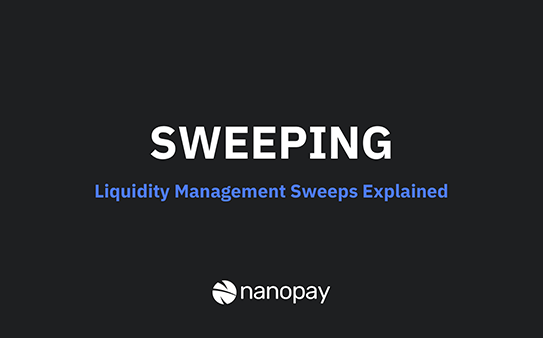Many large organizations have offices around the world, which can make it difficult to know how much money the entire company has at any given time. In order to run their business more efficiently, companies look to pool their money into one account typically held at head office. This can be a challenge, as large organizations will have hundreds of bank accounts spread across multiple continents. In order to simplify the process of centralizing their cash, companies and their banks work together, using a technique called sweeping.
Sweeping allows banks to transfer funds (on behalf of an organization) out of multiple bank accounts into one account at the end of a given day. HINT: Think sweeping dust from around your house into one spot, but we don’t throw it in the trash at the end!
There are 2 main types of sweeps:
- Zero Balance Account (ZBA): This type of sweep brings the balance in the account to zero by moving all cash out of the chosen bank accounts and into the main account held by head office.
- Target Balance Account (TBA): This type of sweep uses the same process, but instead of moving all money out of the chosen accounts, an organization would set a target balance, and all money above that amount is swept into the main account held by head office. For example, if the target balance was $100 and the account had $250, then the difference of $150 would be swept to head office.
Benefits of sweeping
There are multiple reasons for organizations to use sweeping, but the main benefits are:
- Improve oversight: Centralizing money into one space lets treasurers have visibility into global holdings, so they can make better management decisions.
- Maximize returns on extra cash: By knowing how much money they have, a company can invest their excess capital in the most efficient way possible.
- Save on interest: Corporations hold so many accounts, sometimes they have accounts that are in the negative (overdraft) accruing interest, while other accounts have more money than necessary. By sweeping, the organization can minimize the interest by moving money from positive balance accounts to negative balance accounts.
How sweeping is done
Companies can set up sweeps by giving their bank pre-arranged instructions, similar to how individuals can set up recurring transfers between their accounts. This allows the bank to follow the same process everyday. Remember that, even though the sweep is completed at the same time everyday, many companies now do business across multiple time zones, and that can complicate the process even further. With dozens of accounts and millions of dollars (a day, a week, a month, etc), there is a lot of planning and coordination involved in sweeps.

End-of-day sweeping vs Intra-day:
End-of-day: Given the complexity of sweeping, it is traditionally done at the end of the day. This approach is still favoured by the majority of banks, but it leaves organizations, especially very large ones, open to a certain amount of opportunity loss, as their money could be swept multiple times a day. Using the end-of-day approach means that by the time the money is swept, and moved across multiple borders, it can be 24–72 hours. That is a long time to wait for a company looking to invest their money.
Intra-day: Many banks are switching to an ‘intra-day’ approach to sweeping, which means that the bank can sweep the money on behalf of their client more than once a day. While this is certainly an improvement on the end-of-day approach, many large corporations are looking for instant results.
Real-time: nanopay’s Liquid allows banks to provide their clients self service, real-time sweeps. This means that any time a corporation wants to complete a sweep, they can, and they can do it without relying on the bank to complete the task for them. This frees up a lot of cash for corporates and make their jobs a whole lot faster!





